Layout and features
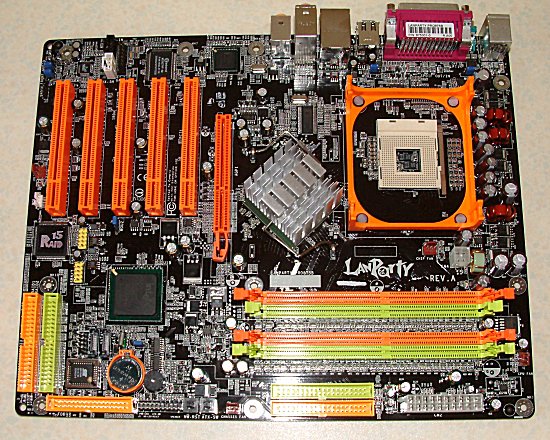
DFI's multicoloured boards strike again. The DFI difference is in having UV-reactive ports and sockets that glow in the presence of UltraViolet light. Definitely one for the case freaks out there. The Northbridge heatsink is cleverly designed to go close to the retention bracket but not foul the installation of a heatsink. A problem may arise through the proximity of the heatsink and AGP slot; it's too close for comfort. DFI uses a 3-phase PWM for stability at 200MHz FSB and beyond. A bank of power-smoothing capacitors line the edge of the board. CPU and heatsink installation is about as easy as it gets on a S478 board. DFI, however, only adds in one fan header close by.
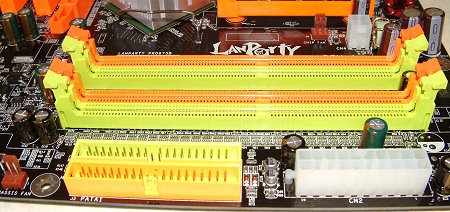
DFI uses a sensible powerplug arrangement on one side of the motherboard. Both 4-pin and 20-pin connectors are located near the PSU's cabling, and DFI scores HEXUS marks for not having wires go across the heatsink area. The LANPARTY PRO875B's based on Intel's premier Canterwood chipset. Thus 4 DIMM slots afford 4GB of unbuffered (ECC and non-ECC) memory. Also present is Intel's Performance Acceleration Technology, which is a soundbite for an efficient link between CPU and system memory. Of course, this being an Intel board, data requests still have to flow through a memory controller located on the Northbridge. Another fan header is located in an odd place, just to the left of the DIMM slots.
DFI uses its own brand of card locking. One has to push aside the locking mechanism to release the card. It's nice and easy with an ASUS Radeon 9800 XT video card but can prove irksome with larger GeForce FX-based adapters. A touch that DFI is increasingly becoming known for is having power and reset buttons located directly on the PCB. They're handy if one is testing outside of a case, which is common when trying out watercooling for the first time. The LANPARTY PRO875B also carries 5 33MHz / 32-bit PCI slots.
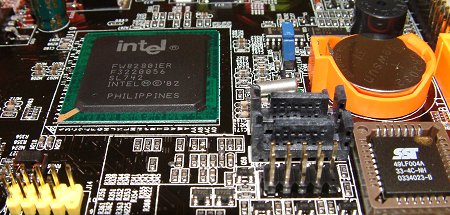
Intel's ICH5R is the natural partner to the i875P's MCH. SATA support that extends to RAID0 and RAID1 formats is standard. That said, the ICH5R is light on features. There's no FireWire support as standard, and DFI, for some inexplicable reason, has left out discrete FireWire support in any form. That's a major omission for a Canterwood board. There's plenty of USB 2.0 connectivity, though, but that doesn't make up for FireWire's conspicuous absence. Very strange.
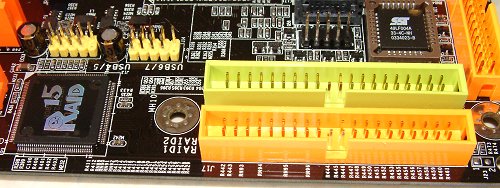
Looking a touch further down shows the PRO875B's storage flexibility. Highpoint's 372N's controller provides IDE ATA133 support in RAID0, RAID1, and RAID1.5 support. RAID1.5 is a strange beast. DFI reckons it provides the advantages of a RAID0+1 array but with only 2 drives. It actually doesn't quite fulfill the criteria for RAID0+1 but is a step in the right direction. Some boards go exclusively with loading SATA to the limit. DFI has the right balance. A floppy port can be seen perpendicular to the two RAIDable Highpoint-driven ports.
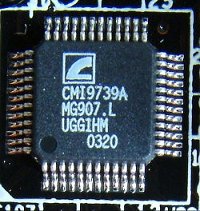
Audio is provided courtesy of Intel's ICH5R's AC'97 sound and CMI's 9739A 6-channel CODEC. Onboard sound is almost always a compromise between cost and quality, yet CMI does a pretty good job with its range of CODECs. We'd prefer any number of Analog Devices' offerings, however.
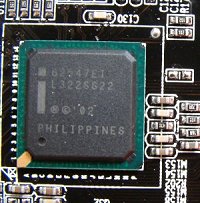
DFI's taken the optimum Canterwood route by adding in Intel's Northbridge-attached fifth-generation Gigabit Ethernet controller. This has the advantage of skipping the limitations imposed by a PCI bus - Southbridge - interconnect - Northbridge routing. Intel's costlier LAN makes sense on a deluxe Canterwood board

4 USB 2.0 ports are integrated on the back panel. Another two are available via the FrontX module and the remaining two of eight can be accessed via motherboard header. RCA jacks for S/PDIF-In and S/PDIF-Out are sensible additions, making full use of CMI's onboard CODEC.
A decent enough layout that's marred by missing FireWire support. There's not too much else to complain about.









